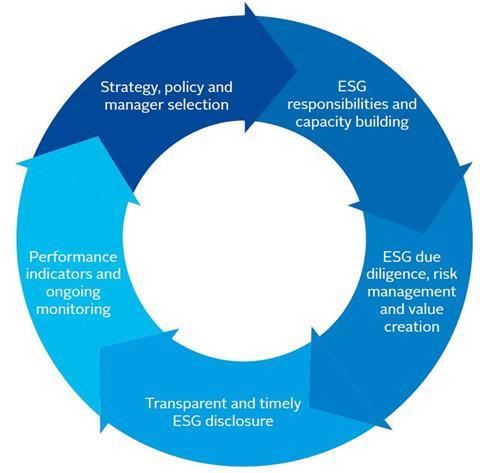The consideration of ESG issues should be an integral part of the forestry investment process, taking into account the long-term nature of forestry investing and the different stages of a forestry investment’s lifecycle.
While different forestry investment strategies will require specific processes tailored to their objectives, the core elements of responsible investing in forestry may include:

Strategy, policy and manager selection:
- embedding ESG considerations in the organisation fs strategy, policies and governance structures, and defining a forestry responsible investment policy;
- using ESG considerations and investment trends, such as climate change and the SDGs, as central elements of asset allocation and portfolio construction; and
- ensuring that the forestry manager selection process considers ESG commitments and past performance, including in relation to certification, and the incorporation of ESG factors into fund or legal terms.
ESG responsibilities and capacity building:
- defining who has ultimate responsibility for ESG performance, at the asset and investor or manager level (ensuring senior management responsibility for ESG performance typically achieves greater buy-in);
- identifying and acting on ESG training needs and information gaps at the fund/manager and asset levels, including for third-party operators or contractors; and
- remaining abreast of, and acting on, developments in ESG best practice in relation to forestry, and updating policies and practices accordingly.
ESG due diligence, risk management and value creation:
- ensuring that ESG due diligence considers the long lifecycle and all facets of forestry operations, from land rights to planting and harvesting, engagement with communities and asset disposal;
- being active owners, whether directly or through managers, by driving performance and engaging on material ESG issues, including in relation to third-party operators; and
- incorporating international best practice on ESG consideration in forestry (such as certification and the IFC Performance Standards) into asset-level policies and performance.
Performance and ongoing monitoring:
- basing ESG KPIs on the most material issues for the investment and overall strategy, which for forestry could include: pure conservation strategies as opposed to sustainable timber production strategies; developed markets as opposed to emerging markets; and plantation forests as opposed to virgin forests.
- tying the KPIs, where possible, to financial reporting or aligning them with management fs financial incentives; and
- ensuring that ongoing monitoring of the investments and/or assets includes performance against ESG KPIs.
Transparent and timely ESG disclosures:
- defining protocols for regular reporting on ESG performance, as well as on an ad-hoc basis for ESG incidents (such as health and safety incidents, wildfires and protests against operations) that reach defined materiality thresholds; and
- ensuring, at a minimum, board awareness of material ESG issues and regular discussion of such issues at risk committee meetings; and considering emerging disclosure requirements based on new regulatory or societal demands, such as the Task Force on Climate- Related Financial Disclosure (TCFD).
Australian asset owner VicSuper’s approach to responsible investment in forestry encompasses many of these elements. For example:
- Prospective timber investment managers must be able to present a comprehensive responsible investment policy.
- The due diligence process requires managers to: adopt relevant third-party certifications; have an approach to protecting biodiversity; consider ESG factors when selecting third-party operators; consider climate change risk; and have a strong approach to community engagement.
- A range of outcomes-focused metrics for managers are defined, such as: hectares planted and harvested; the total population of protected species on the holdings; lost time injury frequency rate; and employment created.
- A regular reporting schedule on ESG performance is also put in place.
Responsible investment in forestry
- 1
- 2
- 3
- 4
 Currently reading
Currently readingIntegrating ESG factors in the forestry investment process
- 5
- 6
- 7













